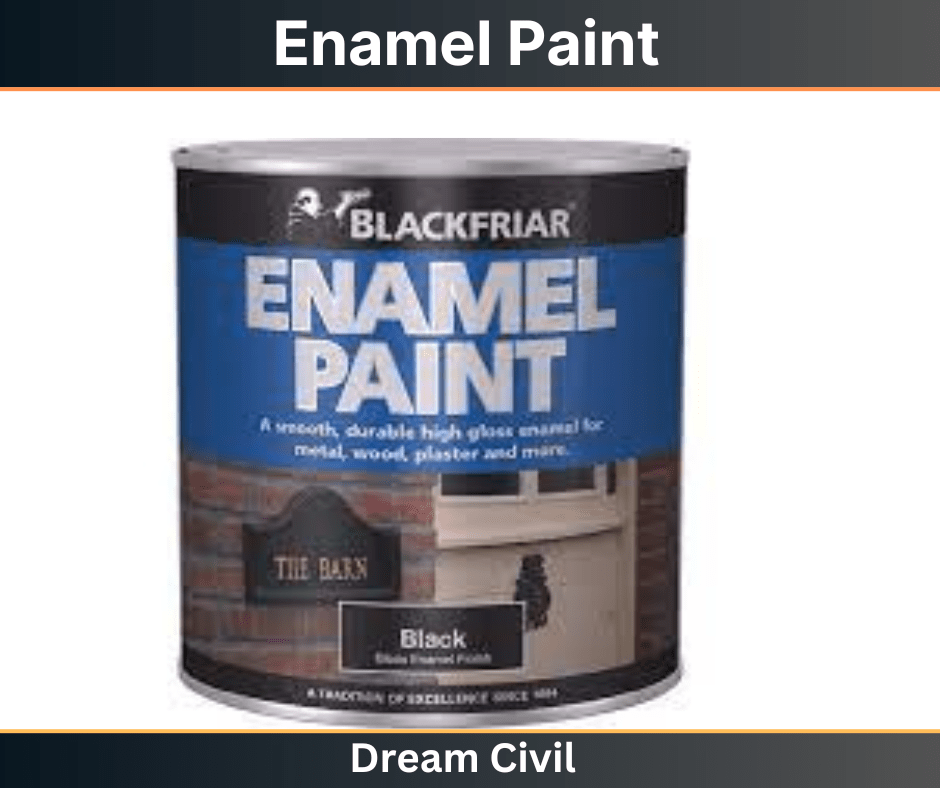Table of Contents
Enamel paint can be defined as the oil-based paint that is used when a highly glossy finish is required.
It consists of white lead, zinc white, resins, and other petroleum products.
It has characteristic coverage and color retention property.
It is slow-drying paint as it dries very slowly.
It is hard in nature and provides a glossy and opaque finish to the surface where it is applied.
It also offers excellent durability and stain-resisting properties.
It may also be water-based.
1. Composition of Enamel Paint
1. Base
White lead, red lead, zinc oxide, iron oxide, titanium white, aluminum powder, or lithophone may be used as the base.
2. Vehicle/Binder
Mostly Linseed oil, alkyd resins, acrylic resin, or epoxy resins are used as the vehicle.
3. Extender/Inert Filler
Usually, colored particles are used as extenders.
4. Solvent/Thinner:
Mostly, the varnish or white spirit is used as the solvent or thinner.
5. Colouring Pigments:
The fine powder of mineral color pigments is used as the coloring pigments.
6. Additives
Various drying additives or pigments such as lead, copper, cobalt, manganese, zirconium, etc may be used as additives.
2. Uses of Enamel Paint
The uses of enamel paint can be listed as follows:
a. It provides an excellent glossy and opaque finish. Thus, it is used extensively for the painting of concrete wall surfaces.
b. It is also suitable for painting doors, windows, staircases, kitchens, and bathrooms.
c. It can also be used for painting the home appliances that are kept outdoors. The enamel paints offer high resistance to moisture, rot, volatile temperatures, and other similar environmental conditions.
d. It can be used both on new surfaces and old surfaces.
e. It can be applied on metal surfaces, woodwork as well as aluminum surfaces.
3. Applications of Enamel Paint
The application of this paint is comparatively easy.
a. It can be applied easily using rollers and brushes.
b. The manufacturer’s instructions must be thoroughly read before the application of the paint.
c. It is mostly not manufactured in a ready-to-use form and thus a small amount of thinner must be added to it prior to the application.
a. Surface Preparation
The surface is prepared using a wire brush or sandpaper. The old coat of paint should be removed finely by scrubbing with sandpaper or wire brushes. The surface should be free from non-uniformity.
b. Cleaning of the Surface
The scrubbed surface should be cleaned properly using a cloth or other cleaning agents.
c. Preparation of Enamel
Paint is prepared according to the manufacturer’s manual by adding a suitable amount of thinner.
d. Application of Enamel
After the preparation; enamel should be applied to the desired surface. Application of paint should be done from top to bottom.
4. Features of Enamel Paint
The features of Enamel Paint are as follows:
a. On the basis of the shade of enamel paint, the range of volatile organic compounds (VOC) may range from 400 to 500 gm/l or no volatile compounds at all.
b. The washability or wipe ability property of the enamel paint depends upon the surface sheen and the specifications of the shade.
c. Enamel paint is available in 500 ml, 1 liter, 4 liters, 10 liter, and 20 Liter packs.
d. The coverage offered by one liter of the enamel paint varies from 70 to 80 sq. ft area for two coats of the paint.
e. The coverage for a single coat is 140 – 160 per liter.
Read More: Emulsion Paint

